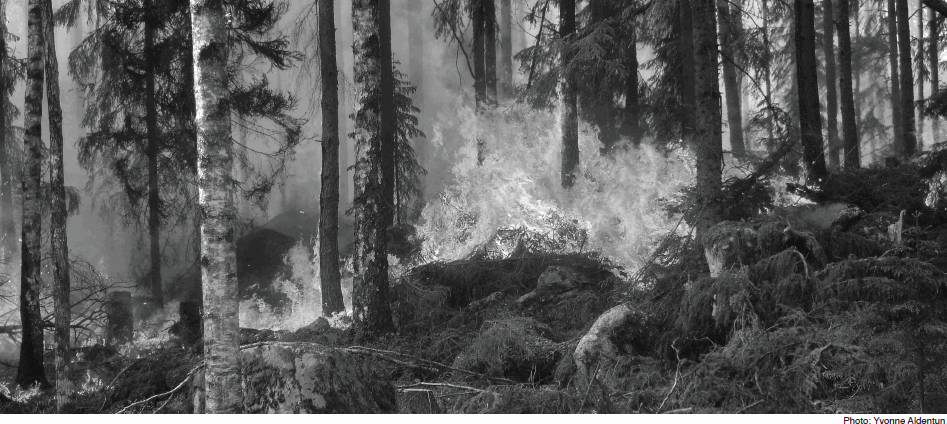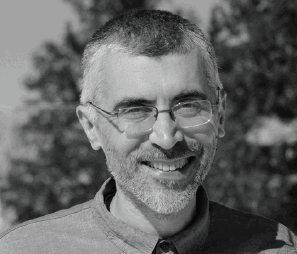
Researchers interested in uneven-aged (from left): Johan Sonesson, Jari Hynynen, Markku Nygren, Adam Felton, Erkki Kauhanen, Annika Nordin, Sauli Valkonen, Riikka Piispanen, Seppo Nevalainen, Tomas Lundmark, Urban Nilsson and Timo Saksa. Photo: Mats Hannerz
Uneven-aged forestry unites Swedish and Finnish researchers
Understanding of the management of uneven-aged forest lags far behind that of traditional forest management. However, it is rapidly advancing and related research will be strengthened with bilateral cooperation. Researchers from Luke (Finland) and Future Forests (Sweden) met for a two-day workshop to discuss the issues.
Even-aged stand management has long been almost the sole forest management method in Finland and Sweden. This approach involves a final harvest with a clearcut, sometimes with retained seed trees. Other methods, such as selection cutting in uneven-aged stands, are still in their infancy, but the interest in such alternatives is increasing among forest owners and the public.
Silvicultural research has followed a similar pattern, with most efforts devoted to even-aged forests.
This means that there is a lack of knowledge about uneven-aged stand management to be transformed into practical guidelines. Research is, however, evolving in both countries, and could expand more if the two joined forces. This was the incentive for the workshop, arranged by the Natural Resources Institute Finland (Luke) and the research programme Future Forests, a cooperation between SLU, Umeå University and Skogforsk in Sweden.
A timely topic
A group of researchers met for two days in Tuusula outside Helsinki to gain an overview of the state of research in uneven-aged forest management and discuss possible cooperation.
– This topic is very timely. Decision makers are increasingly interested in uneven-aged forest management as a way to make the forest landscape more rich in variation, enhancing its ecological and social values, said Professor Annika Nordin (Future Forests) during the opening of the workshop.
She also addressed the need to define what we actually mean by uneven-aged forest management. Dialogue with different stakeholders has revealed a wide range of interpretations, from shelterwood management to multi-layered forests with pure selection cutting.
– In the academy, we have been debating the correct definitions of the various management methods, but now we often use the more open term “clearcut-free” forest management, including all varieties of forest management that do not remove the main part of the tree layer. This makes it easier for us to communicate with the public, she said.
Timo Saksa, regeneration expert at Luke, started by presenting statistics showing that selection cuttings and cuttings that create small gaps account for about 1% of the area of harvesting operations in the Finnish forests. The share is very low, but one has to bear in mind that the current Finnish forest law, allowing selection cuttings, has only been in force since 2014.
Similar figures are not available in Sweden, since the only official data are for clearcuts.
Markku Nygren (Luke) presented results from cone- and seed crop studies in uneven-aged stands, and addressed the need to learn more about how good seed production can be ensured without risking losses of regeneration, growth or genetic diversity.
Sauli Valkonen (Luke) reminded the audience that regeneration costs are zero in uneven-aged forestry, but the presence of sufficient ingrowth depends entirely on the existing undergrowth reserve. ERIKA, a set of experimental plots in 25 stands in southern Finland established to study tree and stand development in managed, uneven-aged Norway spruce stands, have produced many results relating to regeneration and ingrowth.
Annika Nordin and Timo Saksa, who chaired the workshop: “A first joint product will be a report on the state of science”. Photo: Mats Hannerz

Urban Nilsson (SLU) presented results from a thinning experiment series: very extreme thinnings lead to only small losses in yield. He also pointed out that several studies have shown a general decline in productivity of 20–40% in uneven-aged forest stands when compared to even-aged ones.
Jari Hynynen (Luke) had compared about 25 uneven-aged stands from ERIKA with a similar number of even-aged ones. He estimated the annual yield in the uneven-aged stands over a rotation to be about 70% that of the even-aged ones. Profitability was also lower in the uneven-aged stands.
Riikka Piispanen (Luke) had studied wood quality in uneven-aged and even-aged stands. Selected trees in the uneven-aged stands can sometimes be of high quality, suitable for specific purposes. There is great variation in wood quality, both within and among the trees in uneven-aged spruce stands, and the overall conclusion is that the wood quality on average is fairly similar between the two forestry systems.
Johan Sonesson (Skogforsk) presented cost analyses, showing that logging costs in uneven-aged forestry are about 25–30% higher per harvested cubic metre than in even-aged forestry. The revenue per cubic metre is, however, higher in uneven-aged stands, since larger trees are harvested.
Adam Felton (SLU) had studied the implications for biodiversity of different uneven-aged alternatives. Multi-layered forests can lead to more deadwood and more large and old trees, and also a higher structural complexity compared to even-aged forests. Other methods, such as patch cutting and shelterwood regeneration, deliver variable outcomes that are not always positive. One remaining question about multi-layered forests relates to tree species composition – birch and other pioneer species will not regenerate well under the canopy.
Tomas Lundmark (SLU) calculated the climate effects of even-aged and uneven-aged forests. The climate benefit from growing forests is similar in both management systems, provided that the yield is similar. In practice, yield is likely to be lower in uneven-aged forests, thus the climate benefit will be lower.
Seppo Nevalainen (Luke) had investigated damage and risks in different stand types. Uneven-aged forestry is often associated with risks of harvesting damage, root rot and wind felling. In general, however, the risk is not higher than in even-aged stands.
Co-operation will continue
The workshop participants agreed that there is a need to continue to cooperate and share experiences in this highly topical field. The first joint product will be a report on the state-of-the-art science, with accessible articles from the various fields of research, and a consensus article drawing on what is known, and what needs more research. The report will be produced in autumn 2016.
Contacts:
Future Forests: Annika Nordin, [email protected]
Luke: Timo Saksa, [email protected]

Relationship between regional fire activity in Scandinavia and North Atlantic ocean circulation
A research team led by Igor Drobyshev at SLU, Sweden, has shown that fire risk in Scandinavia is linked to a cold sea surface in the North Atlantic.
The study, recently published in Scientific Reports on nature.com, uses modern, dendrochronological and paleochronological records of fires to analyse their links to regional temperature, precipitation and sea surface temperatures of the Northern Atlantic.
– The results confirm our hypothesis that there is a strong and temporally consistent link between a weak North Atlantic Current, a colder sea surface in the Northern Atlantic and a higher fire risk in Scandinavia, says Igor Drobyshev.
The explanation is that a cooling of the interface between cold Greenland and warm North Atlantic currents around the Grand Banks of Newfoundland apparently leads to a weakening of the North Atlantic current, which results in less humid air reaching Scandinavia. In colder periods, western wet winds are directed further south, leaving Scandinavia dry. The critical period is, apparently, April-May, when the correlation between sea surface temperatures and regional fire activity over the whole fire season (typically May to September) was found to be strongest.
– Most research on the effects of North Atlantic climate has been focused on winter climate, since this is the period when ocean–weather feedback is most pronounced.
However, our results show that the ocean–atmosphere interactions during the winter and spring months are important for the summer climate of Scandinavia, he continues.
Igor Drobyshev: “Sea surface temperatures is important for the fire risk in Scandinavia”. Photo: Yun Zhang

Fire is a major disturbance factor in the boreal forests. Although fire is less common in managed forests, at the scale of the whole boreal zone of the Northern Hemisphere, natural fires still represent a major contributor to the total amount of burned biomass. Igor Drobyshev and his colleagues will continue their work with fire regimes.
– We will, for example, use the large fire in central Sweden from 2014 and older large fires reconstructed with the help of tree rings to predict future frequencies of large fires across the country. Understanding the temporal pattern of occurrence of such events across different Scandinavian landscapes helps us to evaluate the relative role of climate and landscape characteristics such as topography in controlling regional fire regimes.
The article can be downloaded from nature.com, http://www.nature.com/articles/srep22532
Contact: Ass. Prof. Igor Drobyshev, Southern Swedish Forest Research Centre, SLU, Alnarp, [email protected]
Research communicators: press-releases are key
Are big data, RSS-feeds and search engines replacing old time communication with journalists? No, according to a survey of 2000 journalists from around the world. Personal relationships and press releases are still top priority for journalists seeking news and article content. This is important information for researchers and research communicators.
The survey shows that journalists struggle under increasing pressure to publish on numerous platforms, but they often feel that they don't have the time to do quality work. This means that it becomes more important to support them with relevant stories and reliable facts.
Press-releases are important
Journalists prefer to go to the original sources, namely a personal contact (e.g. the researchers), but the press release is still considered a relevant source of information for nine out of ten journalists.
As important for research communicators as writing a good press release is to build a relationship with the journalists. This means knowing what sort of content they produce and what they will find useful as stories.

Credibility of the sender
The credibility of the source is a key to whether journalists follow up a story or not. Good quotes from credible people and the opportunity to interview these individuals increase the success rate of a press release.
Lack of time versus depth
Journalists are often frustrated by their lack of time, with short deadlines and a demand to publish on at least three platforms – print, web and social media. But still they prioritise in-depth articles, meaning that they need to access supporting information. The visual content has become more important for journalists, so providing supporting photos and images with press releases is also important.
Source. Journalism Trends 2016, mynewsdesk http://pages.mynewsdesk.com/rs/763-HDU-978/images/Journalism_Trends_2016.pdf
Inspiring title and well-written introduction
Comments from the editor
The survey confirms the advice given by Professor Lena Gustafsson in News & Views No. 3, 2016. She calls for researchers to summarise their results into a format that is easily accessible for journalists and the public, easy to read but still comprehensive enough to pick out a story. If this summary supports a good press release with quotes from a trusted researcher, and visual material is also included, then there is a good chance that the results will attract the journalist.

